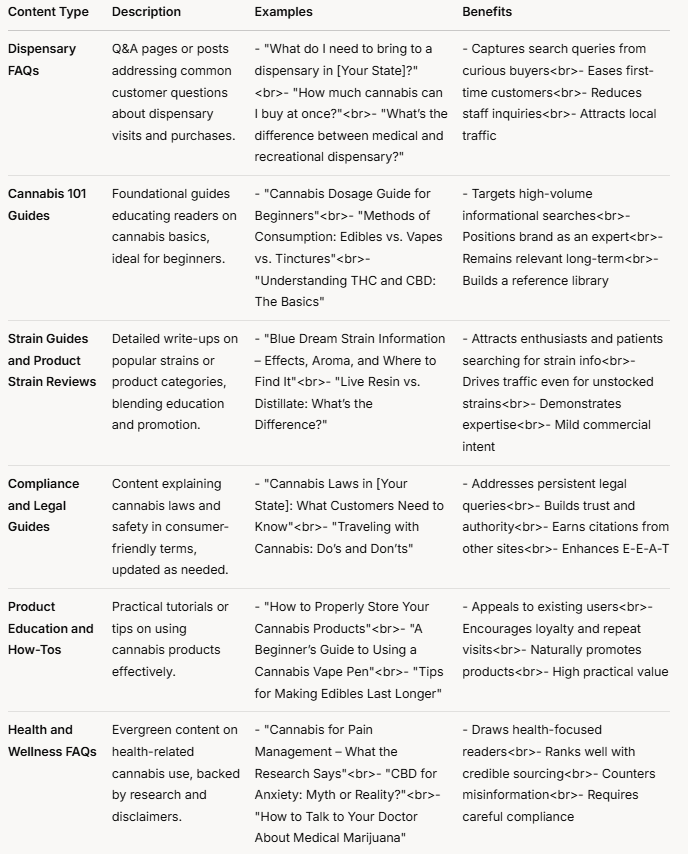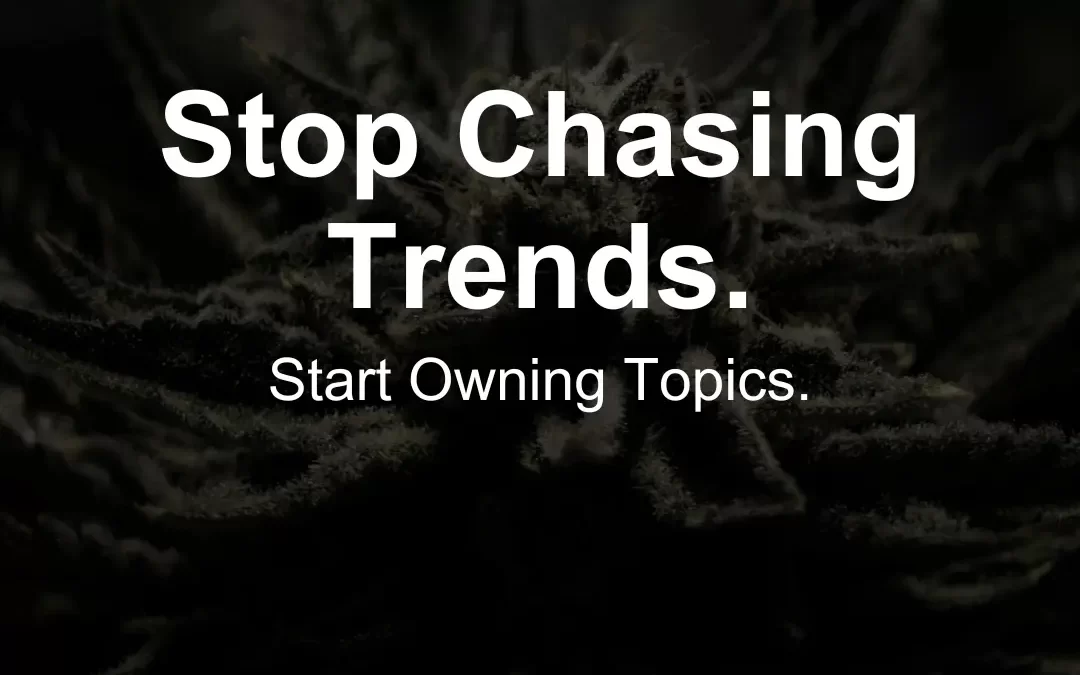Key Points
- Evergreen cannabis content—timeless, valuable topics like “how to choose a cannabis strain”—drives consistent traffic over time.
- Combine keyword research, quality writing, and regular updates keeps content relevant and ranking high in search results.
- Focus on user intent and industry staples (e.g., strain guides, CBD benefits) to ensure long-term SEO success in the cannabis niche.
In the world of cannabis retail, marketing strategies often focus on the latest product drops or seasonal promotions.
Yet one of the most powerful ways to grow your dispensary’s website traffic is by creating evergreen content – content that remains relevant and useful long after it’s published.
Evergreen content provides consistent value to readers over time, helping your site rank on Google and steadily attract new visitors without constant reinvention.
This post will explore how cannabis retailers can leverage evergreen content on both blogs and website pages to boost long-term SEO performance.
We’ll cover why evergreen content matters, the difference between educational and commercial evergreen topics, examples of high-impact content types, and a step-by-step checklist to build content that keeps working for you.
Let’s dive in and turn your cannabis SEO strategy into a gift that keeps on giving.
What Is Evergreen Cannabis Content?
Evergreen content is information that doesn’t lose relevance over time, unlike news updates or seasonal trends.
For cannabis businesses, this could mean guides like “What Is CBD and How Does It Work?” or “A Beginner’s Guide to Cannabis Strains.”
These topics tap into ongoing user needs—education, product selection, and practical advice—making them perfect for consistent traffic.
In a regulated industry where trust matters, evergreen content also reinforces your expertise and keeps visitors coming back.

Educational Vs. Commercial Evergreen Content
Not all evergreen content serves the same purpose.
In cannabis retail, you’ll generally create evergreen pieces that fall into two buckets: educational content and commercial content.
Both types can drive traffic for the long haul, but they address different search intents and customer needs.
Let’s break down the differences with examples.
Educational Evergreen Content
Educational evergreen content is informational in nature.
It aims to teach or inform readers about a topic, without directly pushing a product.
These pieces typically answer common questions or explain core concepts that remain constant over time.
For example, a dispensary blog post titled “What is CBD? Benefits, Effects, and Uses” is classic evergreen educational content.
Even as new research emerges, the fundamental question of “what is CBD” will be asked by consumers for years to come, making it a reliable traffic driver.
Other educational evergreen topics might include
- Indica vs. Sativa: Understanding the Differences
- How to Consume Cannabis Safely as a Beginner
- Guide to Terpenes and Their Effects
Educational content usually targets informational search intent – readers who are looking to learn, not necessarily buy at that moment.
By providing thorough, accurate answers, you build trust with these potential customers.
Over time, your dispensary becomes a go-to knowledge source.
When those readers are ready to purchase, they’re more likely to remember your brand favorably.
Educational evergreen posts often form the top-of-funnel content in your SEO strategy, pulling in a wide audience (including people new to cannabis or researching before their first dispensary visit).
Just remember to keep the language accessible – writing for beginners and avoiding overly technical jargon ensures your content appeals to the broadest audience.
Commercial Evergreen Content
Commercial evergreen content, on the other hand, has a product or purchase angle while still staying relevant over time.
These pieces often target comparison, review, or recommendation queries that indicate a reader is closer to making a buying decision.
For example, “Best THC Gummies For Sleep” is a commercial evergreen topic.
Consumers who search this are likely evaluating products to purchase for better sleep.
You can create a blog post (or a static page) listing the top THC-infused gummies for sleep, with descriptions and why each product is recommended.
This content remains evergreen because the general need – finding effective sleep aids – is ongoing.
You may refresh the specific product recommendations over time, but the topic itself isn’t going out of style.
Other examples of commercial evergreen content include.
- Top 5 Indica Strains for Relaxation
- How to Choose a Vape Pen: A Buyer’s Guide
- CBD Oil vs. Capsules: Which Is Right for You
These pieces mix education with a subtle push toward products, addressing search intents that are informational and transactional.
They are great for capturing mid- to bottom-of-funnel traffic – readers who already know the basics and now want to compare options or find the best product for their needs.
By creating comprehensive, up-to-date commercial evergreen guides, you can lead potential customers straight from Google search to relevant products on your site.
For instance, your “Best THC Gummies” article can link directly to the gummies you sell, shortening the path from content to checkout.
Why Both Matter
A balanced cannabis content strategy will include both educational and commercial evergreen pieces.
Educational content casts a wide net, bringing in visitors and building your brand’s expertise, while commercial content nurtures those visitors closer to a sale.
Both types, if done well, continue to rank and bring traffic over the long term.
Work with a cannabis SEO writer to create evergreen content designed to rank and convert.
Next, we’ll explore exactly what kinds of evergreen topics tend to perform best for cannabis retailers.

Evergreen Content Ideas For Cannabis Retailers
What evergreen topics should your dispensary’s blog or website cover?
To maximize long-term traffic, focus on search-driven questions and themes that cannabis consumers (or even your own potential customers) frequently look up.
You likely already hear many of these questions in-store from customers.
By answering them online, you expand your reach far beyond your storefront.
Here are some high-value evergreen content types and ideas that tend to rank well over time for cannabis businesses.
Dispensary FAQs
An FAQ page or series of Q&A posts that address common customer questions.
For example, “What do I need to bring to a dispensary in [Your State]?”, “How much cannabis can I buy at once?”, “What’s the difference between medical and recreational dispensary?”
Answering these FAQs on your site not only helps first-time customers feel at ease, but also captures search queries from people seeking clarity on purchasing cannabis.
A comprehensive dispensary FAQ can steadily attract local visitors and save your staff time by educating consumers up front.
Cannabis 101 Guides
Foundational guides that educate readers on cannabis basics.
Think of topics like “Cannabis Dosage Guide for Beginners,” “Methods of Consumption: Edibles vs. Vapes vs. Tinctures,” or “Understanding THC and CBD: The Basics.”
These evergreen guides serve as a reference library for curious consumers.
They address high-volume informational searches (e.g., “how to dose edibles” or “THC vs CBD”).
By covering the ABCs of cannabis in an accessible way, you position your brand as an expert resource.
This content remains relevant indefinitely, since new people will always be entering the market needing these answers.
Strain Guides And Product Strain Reviews
Detailed write-ups for popular cannabis strains (or product categories).
For example, a page for “Blue Dream Strain Information – Effects, Aroma, and Where to Find It.”
Cannabis enthusiasts and medical patients constantly search for strain information.
If you carry certain strains at your dispensary, creating evergreen pages for those can capture searchers who might then become customers.
Even if you don’t stock a strain year-round, providing a strain guide still brings traffic and demonstrates expertise.
Similarly, evergreen reviews or explainers for product types (like “Live Resin vs. Distillate: What’s the Difference?”) are useful over the long term.
These pieces tap into both education and mild commercial intent.
Compliance And Legal Guides
Content that explains cannabis laws, regulations, or safety guidelines in a way consumers can understand.
For example, “Cannabis Laws in [Your State]: What Customers Need to Know” or “Traveling with Cannabis: Do’s and Don’ts.”
Law-related content must be kept updated as rules change, but it addresses persistent concerns (people will always wonder about legal limits, ID requirements, etc.).
As an official retailer, you can offer trustworthy guidance on these topics, which can attract not just consumers but also citations from other sites if your info is particularly helpful.
Evergreen compliance content showcases your authority and builds trust – crucial for E-E-A-T – since it shows you prioritize safety and legality.
Product Education And How-Tos
Evergreen tutorials or tip lists related to using cannabis products.
For example, “How to Properly Store Your Cannabis Products to Keep Them Fresh,” “A Beginner’s Guide to Using a Cannabis Vape Pen,” or “Tips for Making Edibles Last Longer.”
These are practical topics that existing consumers search for as they learn to get the most out of what they buy.
A dispensary that offers helpful usage tips is likely to earn loyalty and repeat visits (online and in-store).
Plus, such content can naturally feature your products or services (e.g., mention storage accessories you sell or link to vape pen products in a how-to article), blending value with gentle promotion.
Health And Wellness FAQs
Many cannabis consumers use products for health reasons, so consider evergreen content around themes like “Cannabis for Pain Management – What the Research Says,” “CBD for Anxiety: Myth or Reality?” or “How to Talk to Your Doctor About Medical Marijuana.”
Caution: Health topics in cannabis fall under “Your Money or Your Life” for Google, meaning you should approach with extra care to cite reputable sources and avoid unfounded claims.
When done right (and updated with new findings), health-related evergreen articles can rank well and draw in readers looking for reliable information amidst a sea of misinformation.
Just ensure you include disclaimers and refer to medical professionals or scientific studies where appropriate to maintain trustworthiness.
These are just a few examples – in truth, the well of evergreen content ideas is deep.
The best approach is to brainstorm questions and problems your customers have year-round and create content that directly addresses those queries.
Tools like Google.com (autocomplete) and Answer The Public can help uncover frequently asked questions about cannabis that have steady search volume.
Also, review your dispensary’s customer service queries or social media comments for inspiration.
If one person asked it, many others are probably typing it into Google!
Once you have your list of evergreen topics, it’s time to start creating.
Why Evergreen Content Works For Cannabis SEO
Cannabis SEO thrives on evergreen content because.
- Consistent Traffic: Topics like “benefits of THC vs. CBD” attract searches monthly, not just during trends.
- Authority Building: Detailed, timeless guides establish your site as a go-to resource, boosting E-E-A-T (Experience, Expertise, Authoritativeness, Trustworthiness).
- Cost Efficiency: One well-optimized piece can outperform multiple short-lived posts, saving time and resources.
- Local Adaptability: Evergreen frameworks (e.g., “How to Choose a Dispensary”) can be tailored with local keywords like “Denver dispensary tips.”
How To Create Evergreen Cannabis Content: Step-By-Step Checklist
Here’s how to craft content that drives traffic long-term.
- Target Timeless Topics: Focus on staples like strain education, CBD uses, or legal basics (e.g., “Is Cannabis Legal in My State?”).
- Do Keyword Research: Use tools like Ahrefs and SEMrush to find evergreen terms with steady search volume (e.g., “how to use CBD oil” – 12,000 searches/month).
- Analyze search intent: Informational, transactional, and navigational for each topic.
- Solve User Problems: Address common questions like “What’s the best strain for sleep?” with clear, actionable answers.
- Outline your content: With a problem-solution structure and key subheadings.
- Write High-Quality Content: Aim for 1,500+ words with depth, multimedia (e.g., strain photos), and natural keyword use.
- Optimize for SEO: Include title tags, meta descriptions, and internal links to keep it ranking.
- Add internal links: To related pages or products on your site.
- Publish and promote: Via social media and email newsletters.
- Monitor performance: With Google Analytics; update annually or as needed.
- Repurpose: Into other formats (e.g., videos, infographics) for extra reach.
- Update Regularly: Refresh stats or legal details annually to maintain accuracy.
Building evergreen content that consistently drives traffic requires a mix of strategic planning and solid execution.
Use the following step-by-step checklist as a guide when developing your next blog post or website content piece.
This checklist will help ensure your content is tailored to search intent, optimized for SEO, and positioned to stay relevant over time.
1. Do Keyword Research For Evergreen Topics
Start by identifying keywords and questions that have steady search demand.
Use SEO tools or simply Google’s suggestions to find topics your target audience (cannabis consumers in your market) search for year-round.
Look for terms that are not tied to a specific date or fleeting trend.
For example, “how to clean a bong” likely has consistent interest, whereas “2025 Cannabis Expo highlights” would be short-lived.
Choose keywords that align with evergreen needs, and verify their search volume is stable over the past 12+ months (not peaking only seasonally).
2. Analyze Search Intent And Choose the Right Format
For each topic, determine what the searcher is really looking for.
Is it a straightforward answer, a list of options, a tutorial, a definition?
Align your content format to that intent.
If the query is “best CBD oils for pain relief,” the intent is likely to compare products – a listicle or review format fits best.
If the query is “how to decarb cannabis,” the intent is instructional – a step-by-step how-to article with photos would work well.
Matching content type (e.g., how-to guide, FAQ page, top-10 list, in-depth guide) to user intent will keep readers engaged and satisfied. It also increases your chances of ranking, because Google favors content that serves the searcher’s needs effectively.
3. Create A Comprehensive Outline
Evergreen content should be thorough.
Outline your piece with logical headers (H2s, H3s) covering all subtopics or questions someone might have on the main topic.
For instance, an outline for “Guide to Edibles Dosage” might include sections like “Why Dosage Matters,” “THC vs CBD Edibles – Effects Differences,” “General Dosage Guidelines,” “Tips for First-Time Users,” and “What to Do If You Take Too Much.”
Covering a topic in-depth makes your content more evergreen by default – it won’t become irrelevant because you’ve addressed core aspects exhaustively.
A good outline also helps you naturally incorporate relevant keywords and synonyms throughout, which boosts SEO without “keyword stuffing.”
4. Write High-Quality, Trustworthy Content
With your outline in hand, write the content with a focus on clarity, accuracy, and depth.
This is where E-E-A-T principles come in (Experience, Expertise, Authoritativeness, Trustworthiness).
Aim to provide expert insight – if you have first-hand experience or knowledge (or can quote someone who does), include it.
For example: If you’re writing about CBD for sleep, and your store’s wellness consultant contributes a tip or a personal observation, that adds experience-based value.
Google’s quality guidelines note that content created by someone with ample personal experience tends to rank higher.
Use a professional but conversational tone, as if you’re teaching a curious customer.
Avoid fluff and get to the point, but also ensure the information is accurate and up-to-date.
If citing stats or scientific facts, reference credible sources (link out to government sites, well-known industry publications, or scientific studies).
This not only builds trust with readers but also signals to search engines that your content is reliable.
5. Optimize On-Page SEO Elements
Evergreen or not, basic on-page SEO best practices apply.
Give your piece a clear, keyword-rich title tag and a compelling meta description that encourages clicks.
Use the target keyword (or a close variant) in your main headline and within the first paragraph if possible, in a natural way.
Break up the content with subheaders (H2s, H3s) that also incorporate relevant phrases.
Include images or graphics if they help (e.g., an infographic on the cannabis plant for a cultivation article) and add descriptive alt text to those images.
Use bullet points or numbered lists (like this checklist!) where appropriate to make information digestible.
And of course, proofread carefully – good grammar and spelling contribute to perceived quality.
An optimized, reader-friendly format will help your evergreen pages rank well initially and remain competitive over time.
6. Incorporate Internal Links Strategically
While writing, look for opportunities to link internally to other relevant pages on your site, and after publishing, ensure other pages link to your new content as well.
Internal linking is a powerful yet easy way to boost your content’s SEO.
It helps search engine crawlers find and index your evergreen article, and distributes “link equity” (authority) across your site.
For example, if you mention a specific strain in a blog post, link to the strain’s product page or your strain guide if you have one.
Likewise, update your strain guide page later to include a link back to the new blog post (“Learn more about dosing edibles in our detailed guide here”).
These contextual links not only improve SEO but also keep readers on your site longer by guiding them to related content.
A well-linked piece is far less likely to become an orphan page over time, which helps maintain its ranking strength.
7. Add A Touch Of Expertise And Personality (E-E-A-T)
Beyond just factual accuracy, try to showcase expertise and authoritativeness in your content.
This could mean having a subject matter expert at your dispensary co-author or review the article.
It could also mean adding an author bio at the end that highlights the writer’s credentials or experience in the cannabis industry (e.g., “Budtender with 5 years experience” or “Certified cannabis sommelier”).
This lends credibility and aligns with Google’s emphasis on author authority for YMYL topics.
Also, if you have first-hand experience to share (like a brief anecdote of how a certain strain helped a real customer, with their permission), that experience element can make the content more engaging and trustworthy.
The tone can remain conversational – you want readers to feel like they’re getting advice from a knowledgeable friend, not being lectured.
By humanizing your evergreen content with real insights and a confident voice, you fulfill the E-E-A-T criteria while keeping it approachable.
8. Publish And Promote The Content
Once your evergreen piece is written and polished, publish it on an optimized page (ensure the URL is clean and includes keywords, e.g., /blog/what-is-cbd-guide).
Then give it an initial push.
Share it on your social media, include it in your email newsletter, or even feature it in-store (“Check out our blog for a beginner’s guide to cannabis!”).
Early traffic and engagement can help signal to Google that this content is worth ranking.
Promotion isn’t a one-time thing either – because the content stays relevant, you can reshare it periodically.
For example, post your “Cannabis Storage Tips” article at the start of every summer and winter when storage needs change, reminding followers of its value.
While promotion isn’t directly an SEO factor, it indirectly helps by attracting readers who might link to it or by boosting the on-page engagement metrics (time on page, etc.) that search algorithms notice.
9. Monitor Performance And On-Site Engagement
Use Google Analytics or your preferred analytics tool to keep an eye on how your evergreen content is performing.
Is it gaining organic traffic over the months?
Which keywords is it ranking for, and are those positions improving?
Also, check user behavior.
What’s the bounce rate?
Do readers scroll through most of the article or drop off early?
This data can guide tweaks to improve the content’s stickiness and relevance.
If you notice, for instance, that visitors frequently exit the page after a certain section, perhaps that part of the content isn’t addressing their needs and needs revision.
Monitoring ensures your evergreen content doesn’t just sit static; you’ll catch opportunities to refine it so it continues to meet search intent better than any newer competitors that arise.
10. Update Periodically To Keep Content Fresh
One hallmark of true evergreen content is that it’s regularly refreshed to stay accurate and useful.
Set a schedule (e.g., a content audit every 6 months) to revisit your evergreen pieces.
Update any outdated information (laws change, new studies come out, product availability shifts).
Add new insights that have emerged since the original publish date – this could be a new FAQ section based on reader comments or a new recommendation in your “best products” list for the year.
Small updates can have a big impact.
Search engines often favor content that shows recent updates for queries where information can evolve.
Even just updating the publish date after making improvements can signal freshness.
Additionally, use this chance to improve the content’s depth – maybe you find a subtopic that competitors added to their articles; you should cover it too to maintain your comprehensive edge.
Routine updates ensure your evergreen content stays evergreen (relevant and high-performing).
It’s far easier to update a great article than to start from scratch constantly, and the SEO benefit is typically faster with updates, since you’re building on an already indexed URL rather than a brand new one.
By following this checklist for each piece of content you create, you’ll build a robust library of evergreen articles and pages that collectively generate consistent organic traffic.
Now that you know the process, let’s talk about some ongoing best practices to maximize the impact of your evergreen content.
Maintaining Evergreen Content Success: E-E-A-T, Internal Links & Updates
Creating evergreen content is not a one-and-done task – it’s an ongoing commitment.
To ensure your cannabis content keeps driving traffic (and doesn’t “rot” on the digital vine), you need to maintain it.
Three key factors to focus on are E-E-A-T, internal linking, and routine updates (we touched on these in the steps, but they’re worth emphasizing on their own).
Emphasize E-E-A-T For Trust and Authority
Google’s algorithm may change over time, but its focus on surfacing helpful, trustworthy content remains constant.
Cannabis topics, especially those related to health or legal issues, can fall under what Google calls YMYL (“Your Money or Your Life”) content – meaning they require a high standard of accuracy and trust.
Continuously demonstrating E-E-A-T in your evergreen posts will help them maintain strong rankings.
This means.
- Ensure the Experience and Expertise of your authors or contributors is clear (update author bios if someone on your team gains a new certification or training), reinforce your site’s
- Authoritativeness by citing authoritative sources and maybe getting backlinks from reputable cannabis sites, and safeguard
- Trustworthiness by being transparent (e.g., if your post is “Best Dispensaries in Denver” make it clear if it’s an opinion piece, and don’t mislead readers).
Little things like having a clear editorial policy, privacy policy, and contact information on your site also boost trust.
Each time you update an evergreen article, double-check it against current industry standards and guidelines so it remains a piece of high-quality content that both users and search engines can rely on.
Leverage Internal Linking As Your Content Grows
Your evergreen content will start forming a content network on your site.
Make sure you weave that network tighter over time.
Whenever you publish a new page or post, ask: “Is there an older evergreen piece that this is related to?”
If yes, go back and add a link.
For example, if you have a long-standing blog post about “How to Get a Medical Marijuana Card” and you just published a new post about “Renewing Your Medical Card,” link them to each other.
Similarly, if you notice one of your evergreen pages is getting a lot of traffic, see if you can direct that traffic deeper into your site via internal links (“Now that you’ve learned about terpenes, check out our strain guide to see which profiles match your needs.”).
The bigger your site gets, the more important internal linking becomes for both SEO and user navigation.
Periodically audit your site for orphan pages or broken links as well, and fix those to keep the link equity flowing.
A well-linked evergreen archive strengthens your site’s overall SEO architecture, making it harder for competitors to outrank your content in the long run.
Schedule Routine Content Refreshes
We mentioned this in the checklist, but it bears repeating: don’t set and forget your evergreen content.
Create a simple calendar or reminder to review content at regular intervals.
When reviewing, do a quick fact check – is everything still accurate post-2023?
Does any section feel thin compared to what newer articles by others are covering?
Could the piece benefit from a fresh example or a new image?
Even adding a paragraph to address a newly popular question (for instance, adding a section about a new cannabinoid like delta-8 or THC-O if those become hot topics) can give your content a new lease on life.
Also consider user feedback.
If your blog allows comments and readers have asked questions, edit the article to answer them within the content (and maybe thank the commenter for the idea).
Regular updates not only improve the content for readers, but search engines appreciate the freshness factor.
An updated evergreen post often sees a rankings boost, reaffirming its relevance. In essence, treat your evergreen pieces as living documents that evolve with the industry and customer needs.
This approach will ensure they continue to rank well and drive traffic for years to come.
Final Thoughts: Grow Your Traffic Aith Evergreen Content
Evergreen content is a cornerstone of effective cannabis SEO.
By investing time in well-researched, high-quality posts and pages that address enduring topics, cannabis retailers can reap a steady stream of organic traffic and customer engagement.
Instead of scrambling to produce “viral” content that fades quickly, a library of evergreen articles works for you around the clock, educating consumers and subtly guiding them toward your business.
Remember to balance both educational and commercial topics so you’re attracting readers at all stages of the buyer journey.
Use the checklist provided to plan and execute each piece with SEO and longevity in mind.
And don’t forget to nurture your content over time – even the sturdiest evergreens benefit from a little pruning and care!
By following the guidance in this post, you’ll be well on your way to building a robust content presence that elevates your dispensary’s online visibility above the competition.
If you find yourself short on time or need expert help crafting content that consistently ranks, consider tapping into a professional content SEO service.
At Hemp Writer, we specialize in creating evergreen cannabis content that drives long-term traffic and conversions for retailers.
Whether you DIY or get outside help, the key is to start planting those evergreen seeds now.
In a year’s time, you’ll be thankful for the sustainable growth as you watch your organic traffic flourish like a well-tended garden.
Here’s to content that keeps on giving!




